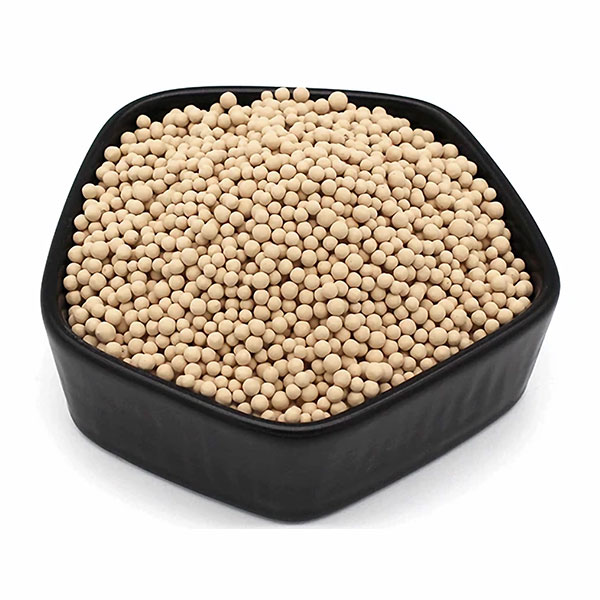Understanding 3A Molecular Sieve: A Key to Efficient Adsorption
2025-02-14
A 3A molecular sieve is a type of adsorbent material that plays a crucial role in various industries due to its ability to selectively adsorb molecules based on their size. It is commonly used for drying and purifying gases and liquids, as well as in applications that require the removal of specific impurities. This article explores the structure, properties, and common uses of 3A molecular sieves, highlighting their importance in modern technology.
What is a Molecular Sieve?
A molecular sieve is a material with a porous structure that allows it to adsorb certain molecules while excluding others. The pores within the sieve are very small, typically ranging from a few angstroms to nanometers in size. These sieves are designed to adsorb molecules that are smaller than the diameter of their pores, while larger molecules are unable to enter. The specificity of molecular sieves makes them incredibly useful in a variety of applications, including gas separation, water purification, and chemical synthesis.
3A molecular sieve is one specific type of molecular sieve that has pores with a size of approximately 3 angstroms (0.3 nanometers). This pore size makes it highly selective, meaning it can adsorb molecules with diameters up to 3 angstroms while leaving larger molecules unaffected.
How Does 3A Molecular Sieve Work?
The fundamental principle behind 3A molecular sieve is adsorption, which involves the attraction of molecules to the surface of the material. This process is driven by forces like van der Waals forces, which allow molecules to stick to the surface of the sieve.
When gases or liquids pass through the molecular sieve, the smaller molecules that fit into the sieve’s pores are adsorbed, while larger molecules are not able to enter. This selectivity makes 3A molecular sieves particularly effective for separating or purifying specific components in a mixture.
In the case of a 3A molecular sieve, its pore size primarily targets the removal of water molecules, as water molecules are typically smaller than 3 angstroms in diameter. Therefore, it is highly effective in applications where water needs to be removed from a substance without affecting larger molecules.
Key Properties of 3A Molecular Sieve
1. High Selectivity: The primary feature of a 3A molecular sieve is its ability to adsorb molecules based on size. This selectivity makes it ideal for applications where only certain substances need to be removed from a mixture.
2. Adsorption Capacity: 3A molecular sieves have a high capacity for adsorbing water and other small molecules. This makes them particularly useful in drying applications, where moisture removal is essential.
3. Regenerability: 3A molecular sieves can be regenerated after they have adsorbed moisture or other molecules. This is typically done by heating the sieve to release the adsorbed substances, allowing the sieve to be reused for further adsorption cycles.
4. Stability: 3A molecular sieves are chemically stable and can withstand a variety of harsh conditions, including high temperatures and acidic or alkaline environments, making them suitable for many industrial applications.
5. Non-toxic and Safe: These sieves are made from materials like alumina and silica, which are non-toxic and safe to handle, making them suitable for use in various food and pharmaceutical applications.
Common Uses of 3A Molecular Sieve
1. Gas and Liquid Drying: One of the most common uses of 3A molecular sieves is in the drying of gases and liquids. In natural gas processing, for example, 3A molecular sieves are used to remove water from natural gas, preventing corrosion and ensuring the quality of the gas. Similarly, they are used to dry solvents, oils, and other chemicals.
2. Oxygen Generation: In medical applications, 3A molecular sieves are used in oxygen concentrators, where they help separate nitrogen from air, allowing concentrated oxygen to be delivered to patients.
3. Separation of Hydrocarbons: 3A molecular sieves can selectively adsorb certain hydrocarbons while leaving others behind. This makes them useful in petroleum refining and petrochemical processes where precise separation is necessary.
4. Purification of Gases: In industrial processes where gases must be purified, such as in the production of nitrogen or hydrogen, 3A molecular sieves are used to remove trace amounts of water or other contaminants from the gas streams.
5. Dehydration of Air: 3A molecular sieves are also commonly used in air dryers to remove moisture from compressed air. This is important in industrial settings, such as in pneumatic systems or where dry air is required for specific processes.
6. Food and Pharmaceutical Applications: Because they are safe and non-toxic, 3A molecular sieves are used in the food and pharmaceutical industries for drying and purification processes. For example, they can be used to remove moisture from certain food ingredients or to dry packaging materials.
Advantages of Using 3A Molecular Sieve
1. Efficiency: The ability to selectively adsorb smaller molecules like water while leaving larger molecules untouched makes 3A molecular sieves extremely efficient in applications requiring moisture removal or molecular separation.
2. Cost-Effectiveness: Despite their specialized nature, 3A molecular sieves are often cost-effective because they can be regenerated and reused multiple times, reducing the need for frequent replacement.
3. Energy Savings: In applications like gas drying or air dehydration, 3A molecular sieves can help save energy by eliminating the need for more energy-intensive methods of moisture removal, such as refrigeration or desiccation.
4. Versatility: 3A molecular sieves are highly versatile and can be used in a wide range of industries, from natural gas processing to food and beverage production. Their ability to handle different gases and liquids makes them indispensable in modern manufacturing processes.
Conclusion
3A molecular sieves are essential tools in various industrial and commercial applications, known for their high selectivity, adsorption capacity, and versatility. Their ability to efficiently remove water and other small molecules from gases and liquids has made them indispensable in industries such as natural gas processing, air drying, and pharmaceutical manufacturing. As technology continues to evolve, 3A molecular sieves will remain a crucial component in ensuring the quality, safety, and efficiency of many processes in a wide range of industries.



